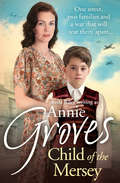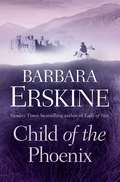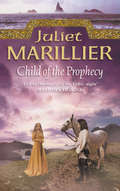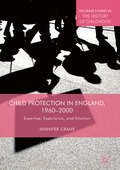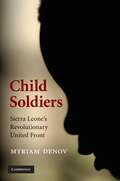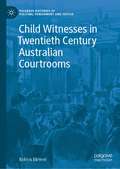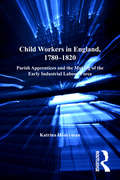- Table View
- List View
Child of Our Time: A Young Girl's Flight from the Holocaust
by Ruth L. DavidPlucked from deepest rural Germany, after witnessing the horror of Kristallnacht and her family's eviction from its village, Ruth David was sent to England as part of the Kindertransport, one of the few routes to safety and survival for so many children who were to lose their parents in the Holocaust. But survival at what price? As a suspicious 'enemy alien' in England at the outbreak of war with little English and few friends, Ruth grew up in loneliness, under the brutal eye of two Viennese ladies who ran the refugee hostel for Austrian, German and Czechoslovak girls where she lived. Their quasi-Dickensian coldness only exacerbated the pain of loss and terrible insecurity that haunted Ruth over these years. As the months of war crawled by, the hostel she lived in gradually turned into an orphanage, as the news from the camps first trickled and then poured in - Rivesaltes, Gurs and Drancy, but also Buchenwald, Theresienstadt and Auschwitz – where Ruth parents perished in 1942.But Ruth survived – luckier than most – to rebuild her life as a teacher both in England and America. Here is the profoundly human story of a little girl caught in the vortex of one of history's great horrors.
Child of Sin
by Meg HutchinsonLizzie Burton is an orphan of mysterious origins. She has been a housemaid at Portland House for as long as she can remember. Deborah Hammond is also an orphan from the workhouse and, like Lizzie, has been in service since childhood. All the girls have is each other so when Lizzie gets pregnant and is dismissed, Deborah goes with her. Sadie Trent is the kindly seamstress who takes them in and finds them work with the exclusive dressmaker she works for. However there is more to the dressmaker's business than meets the eye and as the tragedy of Lizzie's life unfolds Deborah finds herself drawn into a dangerous underworld. Can there ever be a happy ending for a child of sin?
A Child of the Dales
by Diane AllenSet deep in the Yorkshire Dales, Diane Allen’s A Child of the Dales is a sweeping novel of family, deceit, separation and love.Abandoned as a baby on the steps of a remote inn, Ruby Blake has been raised by the innkeeper’s wife, Martha Metcalfe, unknowing of the family searching for her. One wild stormy night, Ruby is reunited with her long-lost father, who wants to whisk her away to Banksgill Farm for a happy life with her true family. Feeling betrayed by Martha, Ruby follows her father for the chance of a new life.However, Ruby is quickly outcast from her real family for being born of Romani blood by everyone but the charming stable hand, Tom Adams. Struck with loneliness in a village of people who find ways to make her miserable, she seeks friendship and love in Tom. As their relationship blossoms, Ruby is faced with the temptations of a handsome local miner, and when rumours begin to spread, Ruby feels more lost and confused than ever.With his long-lost daughter now safely under his wing, Reuben Blake is still desperately searching for Ruby’s mother, and vows he will not rest until he finds his true love. With Rueben’s mission leading him to the darkest corners of Brough Hill, his search shows only signs of heartbreak and despair. As neither father or daughter feel quite whole, will either finally find where they truly belong?
A Child of the East End: The heartwarming and gripping memoir from the queen of saga fiction
by Jean Fullerton'Vivid, unsentimental and very funny. An extraordinary celebration of a by-gone era by the Queen of the East End' Kate Thompson, author of The Stepney Doorstep Society*** Featured on WOMAN & HOME and PEOPLE'S FRIEND, and coming soon to BBC RADIO! ***One of my first East London memories is lying in bed, listening to the low boom of the barges as they nudged each other on the Thames, just half a mile away from our estate . . . Life in Cockney London was tough in the post-war years. The government's broken promises had led to a chronic housing shortage, rampant crime and families living in squalor. But one thing prevailed: the unbeatable spirit of the East End, a tight-knit community who pulled through the dark times with humour and heart.Drawing on both family history and her own memories of growing up in the 1950s and '60s, as well as her working life as a district nurse and local police officer, Jean Fullerton vividly depicts this fascinating part of London - from tin baths, to jellied eels, to tigers in a Wapping warehouse.***Includes a bonus 8-page photo plate section!***A Child of the East End is an eye-opening, heartfelt and atmospheric portrait of life in the East End after the war from 'the queen of saga fiction', perfect for fans of My East End by Gilda O'Neill and Call the Midwife by Jennifer Worth.-FIND OUT WHY READERS ARE FALLING IN LOVE WITH JEAN FULLERTON: 'Food for the soul, it's simply deliciously readable and enjoyable' LoveReading'Charming and full of detail... You will ride emotional highs and lows... Beautifully written' The Lady on A Ration Book Daughter 'A delightful, well researched story' bestselling author Lesley Pearse'A real page-turner with larger-than-life characters and convincing period detail' Daily Express
Child of the Holocaust: A Jewish Child in Christian Disguise
by Jack KuperWhat would you do if, at nine years of age, you arrived home to find your family and friends had disappeared, rounded up by the Nazis? Jack Kuper lived this nightmare, and Child of the Holocaust is the suspenseful true story of his desperate attempts to survive persecution and extermination in Poland. Forced to abandon his Jewish upbringing and disguise his true identity to hide from the death squads, Jack grew up a stranger in his own skin. Initially finding refuge with a local family, Jack's youthful tenderness for daughter-of-the-house Genia belies the terrifying aggression and virulent destruction outside. Eventually turned out by a loving foster mother in fear for her family's life, Jack wandered the treacherous Polish soil. This is his unforgettable account of suffering and, ultimately, survival in the face of the most extreme privation and hatred. For this new edition of a lost classic, Jack Kuper has revisited the manuscript for the first time since he wrote it more than forty years ago, adding new material and including the real names of those who helped him.
Child of the Mersey
by Annie GrovesA brand new series from the bestselling author of A Christmas Promise. Perfect for fans of Katie Flynn.
Child of the Phoenix
by Barbara ErskineBeautiful repackage of this Barbara Erskine classic, the story of a remarkable mediaeval noblewoman whose life shaped the history of three crowns
Child of the Prophecy: Daughter Of The Forest, Son Of The Shadows, Child Of The Prophecy (The Sevenwaters Trilogy #3)
by Juliet MarillierRecalling the lost Celtic past to life, this rich, magical story of loyalty and love is a new Mists of Avalon for readers of historical fantasy.
Child of the Ruins: a gripping, heart-breaking and unforgettable World War Two historical thriller
by Kate Furnivall'A poignant love story' THE iTwo families divided by war.An entire city on the edge of disaster.'I was blown away not just by the gripping story, which had my heart thumping at times, but the sheer eloquence of writing. It is a story of the strength of the human spirit, and of love which will not be defeated. I know I will be recommending it to everyone' LESLEY PEARSE1948, Berlin. World War II has ended and there is supposed to be peace; but Russian troops have closed all access to the city. Roads, railway lines and waterways are blocked and two million people are trapped, relying on airlifts of food, water and medicine to survive. The sharp eyes of the Russian state police watch everything; no one can be trusted.Anna and Ingrid are both searching for answers - and revenge - in the messy aftermath of war. They understand that survival comes only by knowing what to trade: food; medicine; heirlooms; secrets. Both are living in the shadows of a city where the line between right and wrong has become dangerously blurred. But they cannot give up in the search for a lost child . . . 'An absolute triumph' DINAH JEFFERIES'Vivid, brave and suspenseful' RACHEL HORE'I defy anyone not to read beyond the first killer sentence' JANE CORRY'A harrowing and compelling portrait of Berlin in the aftermath of World War Two, told through the interconnecting stories of two courageous women struggling to survive in the rubble of their war-torn city' FIONA VALPY*** READERS LOVE THIS NOVEL! ***'The plot is exciting and fast paced. Thought-provoking and multi-layered as well as thoroughly entertaining. A perfect read' 'Furnivall masterfully captures the history of a divided Berlin in the aftermath of WW2''This novel draws you in with its incredibly well-researched historical fiction and tenacious female leads''A sweeping historical drama that's powerful and tense, full of espionage, making you feel like you're living in post-war Berlin... Beautifully written''This was such an emotive and immersive read that certainly stayed with me long after finishing the pages ... I literally couldn't put this book down. A brilliant story''Such an emotional, powerful, well-written, totally gripping book. I was blown away'
The Child On Platform One: Inspired
by Gill Thompson'An outstanding book made more poignant as it's threaded with events that actually happened. The characters and their moving stories will haunt you long after you finish the last page' Shirley Dickson, author of The Orphan Sisters'OH MY HEART! Moved me DEEP FROM WITHIN. I cannot recommend it enough' The Writing Garnet'I was RIVETED... I LOVED the book *****' I'm Hooked on BooksInspired by the real-life escape of thousands of Jewish children from Nazi-occupied Europe on the Kindertransport trains to London, the new novel from the author of The Oceans Between Us Gill Thompson. For readers of The Tattooist of Auschwitz Heather Morris, My Name is Eva by Suzanne Goldring and A View Across the Rooftops by Suzanne Kelman.Prague 1939. Young mother Eva has a secret from her past. When the Nazis invade, Eva knows the only way to keep her daughter Miriam safe is to send her away - even if it means never seeing her again. But when Eva is taken to a concentration camp, her secret is at risk of being exposed.In London, Pamela volunteers to help find places for the Jewish children arrived from Europe. Befriending one unclaimed little girl, Pamela brings her home. It is only when her young son enlists in the RAF that Pamela realises how easily her own world could come crashing down.Some of the 5* reader reviews for THE CHILD ON PLATFORM ONE:'Such a gorgeous book. I loved and believed in all the characters, and thoroughly enjoyed their stories. Incredibly researched, it felt authentic. And the ending moved me to tears *****''OMG What an incredible read. It was so emotional about a Jewish girl. I was engrossed from start to finish and would highly recommend this book *****''This book was incredible... The story is realistic and believable. Once you start reading you will not want to stop *****''An emotional, haunting book filled with secrets throughout. Excellent *****''I loved the book and the way it was written. I will be reading more novels by Gill Thompson in the future as her interweaving of events with fictional characters is remarkable *****''This was a great book! There are secrets you will not see coming, but it makes it more heartwarming *****''It's not your normal evacuee story as it's intertwined with other stories which I really enjoyed. It had me gripped. I will be looking out for more books by this author *****''This is a very good book. I recommend you read *****'
Child on the Doorstep
by Anne BennettThe heartbreaking new novel from the bestselling author of The Forget-me-not Child and If You Were the Only Girl.
Child Protection in England, 1960–2000: Expertise, Experience, and Emotion (Palgrave Studies in the History of Childhood)
by Jennifer CraneThis book is open access under a CC BY 4.0 license.This open access book explores how children, parents, and survivors reshaped the politics of child protection in late twentieth-century England. Activism by these groups, often manifested in small voluntary organisations, drew upon and constructed an expertise grounded in experience and emotion that supported, challenged, and subverted medical, social work, legal, and political authority. New forms of experiential and emotional expertise were manifested in politics – through consultation, voting, and lobbying – but also in the reshaping of everyday life, and in new partnerships formed between voluntary spokespeople and media. While becoming subjects of, and agents in, child protection politics over the late twentieth century, children, parents, and survivors also faced barriers to enacting change, and the book traces how long-standing structural hierarchies, particularly around gender and age, mediated and inhibited the realisation of experiential and emotional expertise.
Child Sexual Abuse in Victorian England (Women's and Gender History)
by Louise A. JacksonChild Sexual Abuse in Victorian England is the first detailed investigation of the way that child abuse was discovered, debated, diagnosed and dealt with in the Victorian and Edwardian periods.The focus is placed on the child and his or her experience of court procedure and welfare practice, thereby providing a unique and important evaluation of the treatment of children in the courtroom. Through a series of case studies, including analyses of the criminal courts, the author examines the impact of legislation at grass roots level, and demonstrates why this was a formative period in the legal definition of sexual abuse. Providing a much-needed insight into Victorian attitudes, including that of Christian morality, this book makes a distinctive contribution to the history of crime, social welfare and the family. It also offers a valuable critique of current work on the history of children's homes and institutions, arguing that the inter-personal relationships of children and carers is a crucial area of study.
Child Sexual Abuse in Victorian England (Women's and Gender History)
by Louise A. JacksonChild Sexual Abuse in Victorian England is the first detailed investigation of the way that child abuse was discovered, debated, diagnosed and dealt with in the Victorian and Edwardian periods.The focus is placed on the child and his or her experience of court procedure and welfare practice, thereby providing a unique and important evaluation of the treatment of children in the courtroom. Through a series of case studies, including analyses of the criminal courts, the author examines the impact of legislation at grass roots level, and demonstrates why this was a formative period in the legal definition of sexual abuse. Providing a much-needed insight into Victorian attitudes, including that of Christian morality, this book makes a distinctive contribution to the history of crime, social welfare and the family. It also offers a valuable critique of current work on the history of children's homes and institutions, arguing that the inter-personal relationships of children and carers is a crucial area of study.
Child Sexual Abuse Reported by Adult Survivors: Legal Responses in England and Wales, Ireland and Australia (Routledge SOLON Explorations in Crime and Criminal Justice Histories)
by Sinéad Ring Kate Gleeson Kim StevensonChild Sexual Abuse Reported by Adult Survivors is a wide-ranging and timely critical history and analysis of legal responses to ‘historical’ or ‘non-recent’ child sexual abuse (NRCSA) in England and Wales, Ireland and Australia, each of which represents an evolving and progressive approach to this important and complex issue. The book examines the emergence of NRCSA as a distinctive social, political and legal phenomenon in each country and explores the legal responses developed to address its unprecedented challenges. Courts and parliaments in each country have reformed existing doctrine and practice and have created new ways of holding state and private actors accountable and new ways of addressing survivors’ injuries. Criminal law, tort law, public inquiries and state reparations have all been to the forefront of these new legal responses, which have transformed law’s engagement with NRCSA survivors and understandings of justice itself. However, despite this undeniable progress, the book identifies ways in which the legal responses developed in each country fail to deliver accountability and recognition to NRCSA survivors and argues that such failures betray the law’s inherent ambivalence to delivering justice for these survivors. Creating new insights into legal responses to this complex contemporary legal, social and political problem, this book will be of great interest to academic lawyers, political scientists and historians, as well as those working on related topics in criminology, sociology, social policy, cultural studies and gender studies.
Child Sexual Abuse Reported by Adult Survivors: Legal Responses in England and Wales, Ireland and Australia (Routledge SOLON Explorations in Crime and Criminal Justice Histories)
by Sinéad Ring Kate Gleeson Kim StevensonChild Sexual Abuse Reported by Adult Survivors is a wide-ranging and timely critical history and analysis of legal responses to ‘historical’ or ‘non-recent’ child sexual abuse (NRCSA) in England and Wales, Ireland and Australia, each of which represents an evolving and progressive approach to this important and complex issue. The book examines the emergence of NRCSA as a distinctive social, political and legal phenomenon in each country and explores the legal responses developed to address its unprecedented challenges. Courts and parliaments in each country have reformed existing doctrine and practice and have created new ways of holding state and private actors accountable and new ways of addressing survivors’ injuries. Criminal law, tort law, public inquiries and state reparations have all been to the forefront of these new legal responses, which have transformed law’s engagement with NRCSA survivors and understandings of justice itself. However, despite this undeniable progress, the book identifies ways in which the legal responses developed in each country fail to deliver accountability and recognition to NRCSA survivors and argues that such failures betray the law’s inherent ambivalence to delivering justice for these survivors. Creating new insights into legal responses to this complex contemporary legal, social and political problem, this book will be of great interest to academic lawyers, political scientists and historians, as well as those working on related topics in criminology, sociology, social policy, cultural studies and gender studies.
Child Soldiers: Sierra Leone's Revolutionary United Front
by Myriam DenovTragically, violence and armed conflict have become commonplace in the lives of many children around the world. Not only have millions of children been forced to witness war and its atrocities, but many are drawn into conflict as active participants. Nowhere has this been more evident than in Sierra Leone during its 11-year civil war. Drawing upon in-depth interviews and focus groups with former child soldiers of Sierra Leone's rebel Revolutionary United Front, Myriam Denov compassionately examines how child soldiers are initiated into the complex world of violence and armed conflict. She also explores the ways in which the children leave this world of violence and the challenges they face when trying to renegotiate their lives and self-concepts in the aftermath of war. The narratives of the Sierra Leonean youth demonstrate that their life histories defy the narrow and limiting portrayals presented by the media and popular discourse.
The Child Thief
by Dan SmithIn the snow, death is not the coldest thing waiting for you...From out of the whiteness, a dark figure comes...December, 1930, Ukraine. After the horrors of war, Luka wants a quiet life with his family. His village has, so far, remained hidden from the advancing Soviet brutality - but everything changes the day a stranger arrives, pulling a sled bearing a terrible cargo: the bodies of two children. When the villagers' fear turns deadly, they think they have saved themselves. And then a little girl vanishes. Luka is the only man with the skills to find the stolen child in these frozen lands. And though his toughest enemy is the man he tracks through the harsh winter landscape, his strongest bond is a promise to his family back home...
Child Witnesses in Twentieth Century Australian Courtrooms (Palgrave Histories of Policing, Punishment and Justice)
by Robyn BlewerThis book considers the law, policy and procedure for child witnesses in Australian criminal courts across the twentieth century. It uses the stories and experiences of over 200 children, in many cases using their own words from press reports, to highlight how the relevant law was – or was not - applied throughout this period. The law was sympathetic to the plight of child witnesses and exhibited a significant degree of pragmatism to receive the evidence of children but was equally fearful of innocent men being wrongly convicted. The book highlights the impact ‘safeguards’ like corroboration and closed court rules had on the outcome of many cases and the extent to which fear – of children, of lies (or the truth) and of reform – influenced the criminal justice process. Over a century of children giving evidence in court it is `clear that the more things changed, the more they stayed the same’.
Child Workers in England, 1780–1820: Parish Apprentices and the Making of the Early Industrial Labour Force
by Katrina HoneymanThe use of child workers was widespread in textile manufacturing by the late eighteenth century. A particularly vital supply of child workers was via the parish apprenticeship trade, whereby pauper children could move from the 'care' of poor law officialdom to the 'care' of early industrial textile entrepreneurs. This study is the first to examine in detail both the process and experience of parish factory apprenticeship, and to illuminate the role played by children in early industrial expansion. It challenges prevailing notions of exploitation which permeate historical discussion of the early labour force and questions both the readiness with which parishes 'offloaded' large numbers of their poor children to distant factories, and the harsh discipline assumed to have been universal among early factory masters. Finally the author explores the way in which parish apprentices were used to construct a gendered labour force. Dr Honeyman's book is a major contribution to studies in child labour and to the broader social, economic, and business history of the late-eighteenth and early-nineteenth centuries.
Child Workers in England, 1780–1820: Parish Apprentices and the Making of the Early Industrial Labour Force
by Katrina HoneymanThe use of child workers was widespread in textile manufacturing by the late eighteenth century. A particularly vital supply of child workers was via the parish apprenticeship trade, whereby pauper children could move from the 'care' of poor law officialdom to the 'care' of early industrial textile entrepreneurs. This study is the first to examine in detail both the process and experience of parish factory apprenticeship, and to illuminate the role played by children in early industrial expansion. It challenges prevailing notions of exploitation which permeate historical discussion of the early labour force and questions both the readiness with which parishes 'offloaded' large numbers of their poor children to distant factories, and the harsh discipline assumed to have been universal among early factory masters. Finally the author explores the way in which parish apprentices were used to construct a gendered labour force. Dr Honeyman's book is a major contribution to studies in child labour and to the broader social, economic, and business history of the late-eighteenth and early-nineteenth centuries.
Childbed Fever: A Scientific Biography of Ignaz Semmelweis
by K. Codell Carter Barbara R. CarterThe life and work of Ignaz Semmelweis is among the most engaging and moving stories in the history of science. Childbed Fever makes the Semmelweis story available to a general audience, while placing his life, and his discovery, in the context of his times. In 1846 Vienna, as what would now be called a head resident of obstetrics, Semmelweis confronted the terrible reality of childbed fever, which killed prodigious numbers of women throughout Europe and America. In May 1847 Semmelweis was struck by the realization that, in his clinic, these women had probably been infected by the decaying remains of human tissue. He believed that infection occurred because medical personnel did not wash their hands thoroughly after conducting autopsies in the morgue. He immediately began requiring everyone working in his clinic to wash their hands in a chlorine solution. The mortality rate fell to about one percent. While everyone at the time rejected his account of the cause of the disease because his theory was fundamentally inconsistent with existing medical beliefs about how diseases were transmitted, in time Semmelweis was proven to be correct. His work led to the adoption of a new way of thinking about disease, thus helping to create an entirely new theory - the etiological standpoint - that still dominates medicine today.
Childbed Fever: A Scientific Biography of Ignaz Semmelweis (Contributions In Medical Studies #No. 39)
by K. Codell Carter Barbara R. CarterThe life and work of Ignaz Semmelweis is among the most engaging and moving stories in the history of science. Childbed Fever makes the Semmelweis story available to a general audience, while placing his life, and his discovery, in the context of his times. In 1846 Vienna, as what would now be called a head resident of obstetrics, Semmelweis confronted the terrible reality of childbed fever, which killed prodigious numbers of women throughout Europe and America. In May 1847 Semmelweis was struck by the realization that, in his clinic, these women had probably been infected by the decaying remains of human tissue. He believed that infection occurred because medical personnel did not wash their hands thoroughly after conducting autopsies in the morgue. He immediately began requiring everyone working in his clinic to wash their hands in a chlorine solution. The mortality rate fell to about one percent. While everyone at the time rejected his account of the cause of the disease because his theory was fundamentally inconsistent with existing medical beliefs about how diseases were transmitted, in time Semmelweis was proven to be correct. His work led to the adoption of a new way of thinking about disease, thus helping to create an entirely new theory - the etiological standpoint - that still dominates medicine today.
Childbirth and the Display of Authority in Early Modern France (Women and Gender in the Early Modern World)
by Lianne McTavishThroughout the early modern period in France, surgeon men-midwives were predominantly associated with sexual impropriety and physical danger; yet over time they managed to change their image, and by the eighteenth century were summoned to attend even the uncomplicated deliveries of wealthy, urban clients. In this study, Lianne McTavish explores how surgeons strove to transform the perception of their midwifery practices, claiming to be experts who embodied obstetrical authority instead of intruders in a traditionally feminine domain. McTavish argues that early modern French obstetrical treatises were sites of display participating in both the production and contestation of authoritative knowledge of childbirth. Though primarily written by surgeon men-midwives, the texts were also produced by female midwives and male physicians. McTavish's careful examination of these and other sources reveals representations of male and female midwives as unstable and divergent, undermining characterizations of the practice of childbirth in early modern Europe as a gender war which men ultimately won. She discovers that male practitioners did not always disdain maternal values. In fact, the men regularly identified themselves with qualities traditionally respected in female midwives, including a bodily experience of childbirth. Her findings suggest that men's entry into the lying-in chamber was a complex negotiation involving their adaptation to the demands of women. One of the great strengths of this study is its investigation of the visual culture of childbirth. McTavish emphasizes how authority in the birthing room was made visible to others in facial expressions, gestures, and bodily display. For the first time here, the vivid images in the treatises are analysed, including author portraits and engravings of unborn figures. McTavish reveals how these images contributed to arguments about obstetrical authority instead of merely illustrating the written content of the books. At the same time, her arguments move far beyond the lying-in chamber, shedding light on the exchange of visual information in early modern France, a period when identity was largely determined by the precarious act of putting oneself on display.






